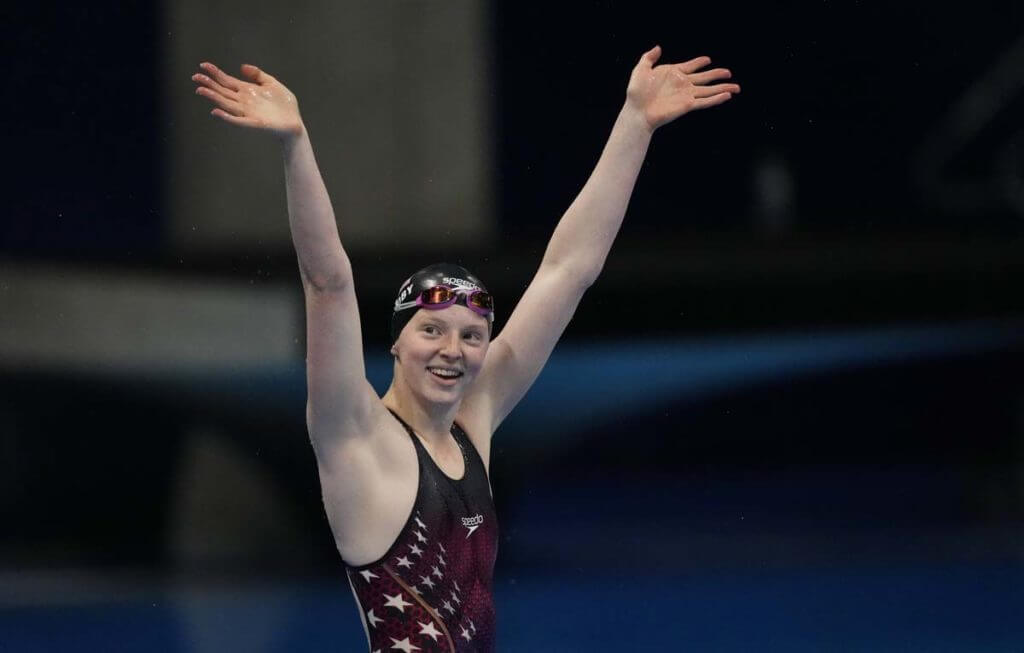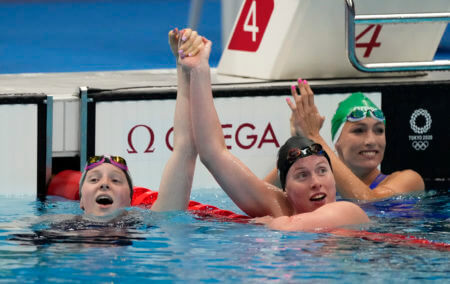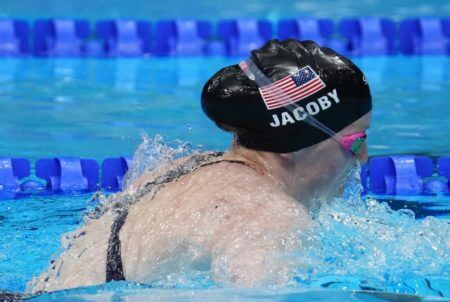Lydia Jacoby: The Rapid Rise from Alaskan Unknown to Gold Medalist

Editorial content for the 2021 Tokyo Olympic Games coverage is sponsored by GMX7.
See full event coverage. Follow GMX7 on Instagram at @GMX7training #gmx7

Lydia Jacoby: The Rapid Rise from Alaskan Unknown to Gold Medalist
If you say you’d heard of Lydia Jacoby before this past April, at least 90% of you are lying. Don’t even bother claiming you correctly predicted that Jacoby would stun the world and win Olympic gold.
Before April, Jacoby’s claim to fame was winning Junior Nationals in the 100 breaststroke in 2019, when she was 15. She swam a 1:08.12 at that meet, and that was her best time before the world entered the COVID-19 pandemic. An early 2020 watch list for 100 breast contenders at Olympic Trials (before the one-year postponement) would not have mentioned Jacoby, even as a longshot.
Jacoby, coached by Meghan O’Leary at Seward Tsunami Swim Club, swam a 1:07.57 at USA Swimming’s multi-site U.S. Open in November 2020, but even at that point, she had not jumped onto the radar as a legitimate contender to make the Olympic team. No way. But she did just that at the TYR Pro Swim Series in Mission Viejo in April, swimming a 1:06.99 in prelims and then a 1:06.38 in finals to finish second behind world-record holder Lilly King. OK, that got some people’s attention. That effort would make her the third overall seed for Olympic Trials. Still, there’s always that slight bit of doubt: is she actually the real deal?

Lilly King (right) helps Lydia Jacoby celebrate winning Olympic gold in the 100 breast — Photo Courtesy: Rob Schumacher/USA Today Sports
Over the past six weeks, Jacoby has proven on every occasion that yes, she is absolutely legitimate. Every time she has raced, she has out-done herself. At U.S. Olympic Trials, she topped Annie Lazor for the No. 2 spot in the 100 breast by swimming a 1:05.28, becoming the first-ever Olympic swimmer from Alaska in the process. She came from way behind to win her semifinal heat at the Olympics, and finally, she overtook top seed Tatjana Schoenmaker and defending gold medalist King to capture gold in Tokyo.
And if swimming fans have only been familiar with Jacoby in recent months, how about general Olympics fans tuning in to watch the 100 breast final and witnessing a 17-year-old from Seward, Alaska, of all places, claiming Olympic gold?
Sure, most of these magical Olympic moments come down to timing and luck, to an extent. King just has not been not at her best in Tokyo, the first time she has delivered a subpar effort at a major meet. After the semifinal, it looked like King had been sandbagging her way through the first two rounds, but surprisingly, she didn’t have another gear. Her top time this year, 1:04.72, was two tenths quicker than the 1:04.95 Jacoby swam to win Olympic gold. Schoenmaker still owns the Olympic record with her 1:04.82 from prelims.
But when Jacoby was close at the 50-meter mark, only three tenths behind Schoenmaker and already even with King, it was clear she had a shot at gold. Her finishing 50 in the final was 34.21, and only one swimmer in the final, fourth-place finisher Evgeniia Chikunova, was within a half-second of that split.
Now, Jacoby is the Olympic gold medalist. Is that real deal enough?
Checking Out the Medley Relay Mayhem
There is one major implication from Jacoby’s win in the 100 breast: she, not King, will handle the breaststroke leg for the U.S. women’s medley relay at the end of the meet, and Jacoby may end up swimming on the mixed medley relay as well. That will be her first time competing on a high-pressured international relay – but of course, the Olympic final was her first race of any kind at a major meet, and she handled that pressure just fine.

Lydia Jacoby competing in the 100 breast final in Tokyo — Photo Courtesy: Robert Hanashiro/USA Today Sports
The American women’s medley relay has mostly taken shape already. Besides Jacoby on breaststroke, she will have fellow teenagers swimming before and after her with Regan Smith on backstroke and Torri Huske on butterfly. The likely candidate to handle the freestyle leg is Abbey Weitzeil, who had the fastest split on the U.S. women’s 400 free relay Sunday morning with her 52.68.
Heading into the Olympics, the consensus was that the Americans were slight favorites in this relay because mostly of the decisive advantage King would provide on the breaststroke leg. With Jacoby in that spot instead, it’s almost a cut-and-paste situation. Jacoby swam a 1:04.95. Among top medley relay countries, here were the top 100 breaststroke performances in Tokyo: China’s Tang Qianting at 1:06.47, Australia’s Chelsea Hodges at 1:06.60 and Canada’s Kelsey Wog at 1:07.73 (although she was almost a second faster at the country’s Trials in June).
That’s a second-and-a-half advantage. So let’s compare composite times, using only times from individual events in Tokyo for backstroke, breaststroke and butterfly and (mostly) 400 free relay splits for the anchor leg.
United States: Smith 57.86 + Jacoby 1:04.95 + Huske 55.73 + Weitzeil 52.68 = 3:51.22
Australia: McKeown 57.47 + Hodges 1:06.60 + McKeon 55.72 + Campbell 52.24 = 3:52.03
Canada: Masse 57.72 + Wog 1:07.73 + MacNeil 55.59 + Oleksiak 52.26 = 3:53.30
China: Peng 59.78 + Tang 1:06.47 + Zhang 55.64 + Yang 52.51 = 3:54.40
Sweden: Coleman 1:00.54 + S. Hansson 1:05.66 + Hansson 56.22 + Sjostrom 51.91 = 3:53.44
This relay will continue to shake out over the next few days with the 100 freestyle scheduled for Wednesday through Friday, but it looks like the Americans are poised to hand the anchor leg a lead of about a second over Australia. And we should note that Weitzeil’s season-best flat-start time (53.52) is about one second behind Cate Campbell’s (52.59).
But however this shakes out, the big American advantage here absolutely comes from the shocking 17-year-old gold medalist, Jacoby.




